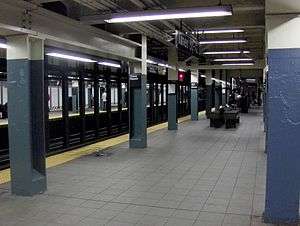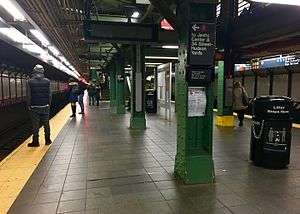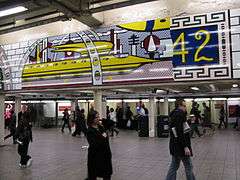Times Square–42nd Street/Port Authority Bus Terminal (New York City Subway)
| Times Square–42nd Street/Port Authority Bus Terminal | |||||||||||
|---|---|---|---|---|---|---|---|---|---|---|---|
| New York City Subway rapid transit station complex | |||||||||||
|
Entrance to the station at 42nd Street & 7th Avenue | |||||||||||
| Station statistics | |||||||||||
| Address |
West 42nd Street, Broadway, Seventh, & Eighth Avenues New York, NY 10036 | ||||||||||
| Borough | Manhattan | ||||||||||
| Locale | Times Square, Midtown Manhattan | ||||||||||
| Coordinates | 40°45′21.6″N 73°59′13.2″W / 40.756000°N 73.987000°WCoordinates: 40°45′21.6″N 73°59′13.2″W / 40.756000°N 73.987000°W | ||||||||||
| Division | A (IRT), B (BMT, IND) | ||||||||||
| Line |
IRT 42nd Street Shuttle BMT Broadway Line IRT Broadway – Seventh Avenue Line IND Eighth Avenue Line IRT Flushing Line | ||||||||||
| Services |
1 2 3 7 A C E N Q R W S | ||||||||||
| Transit connections |
| ||||||||||
| Structure | Underground | ||||||||||
| Levels | 5 | ||||||||||
| Other information | |||||||||||
| Opened | June 3, 1917[1] | ||||||||||
| Accessible |
| ||||||||||
| Wireless service |
| ||||||||||
| Traffic | |||||||||||
| Passengers (2015) |
66,359,208 (complex)[3] | ||||||||||
| Rank | 1 out of 422 | ||||||||||
| |||||||||||
| |||||||||||
Times Square–42nd Street/Port Authority Bus Terminal is a large New York City Subway station complex located under Times Square and the Port Authority Bus Terminal, at the intersection of 42nd Street, Seventh and Eighth Avenues, and Broadway in Midtown Manhattan. It is the busiest station complex in the system, serving 66,359,208 passengers in 2015.[3]
The complex allows free transfers between the IRT 42nd Street Shuttle, the BMT Broadway Line, the IRT Broadway–Seventh Avenue Line and the IRT Flushing Line, with a long transfer to the IND Eighth Avenue Line one block west at 42nd Street–Port Authority Bus Terminal. The complex is served by the:
- 1, 2, 3, 7, A, E, N, and Q trains at all times
- W train during weekdays
- C, R, and 42nd Street Shuttle (S) trains at all times except late nights
- <7> trains during rush hours in the peak direction
Station layout
| G | Street Level | Exits / Entrances |
| B1 | Upper Mezzanines | Fare control, station agent,
Note: Passageway between IND platforms and rest of the complex is a steep grade) |
| Side platform, doors will open on the right | ||
| Track 4 | | |
| Track 3 | | |
| Side platform, doors will open on the left | ||
| Track 1 | | |
| Side platform, doors will open on the left | ||
| B2 Eighth Avenue Line platforms |
Southbound local | ← ← |
| Island platform, doors will open on the left, right | ||
| Southbound express | ← | |
| Northbound express | | |
| Island platform, doors will open on the left, right | ||
| Northbound local | | |
| B2 Broadway – Seventh Avenue Line platforms |
Southbound local | ← |
| Island platform, doors will open on the left, right | ||
| Southbound express | ← ← ← | |
| Northbound express | | |
| Island platform, doors will open on the left, right | ||
| Northbound local | | |
| B2 Broadway Line platforms |
Southbound local | ← ← ← |
| Island platform, doors will open on the left, right | ||
| Southbound express | ← | |
| Northbound express | | |
| Island platform, doors will open on the left, right | ||
| Northbound local | | |
| B3 | Lower Mezzanine | Passageway up to |
| B4 | Southbound Track 1 |
← |
| Island platform, doors will open on the left | ||
| Northbound Track 2 |
| |
The IRT platforms have been connected to each other as a transfer station as the lines opened: first between the 42nd Street Shuttle and the Broadway – Seventh Avenue Line in 1917, then the transfer was incorporated with the Flushing Line in 1927. On December 24, 1932, a 600-foot-long (180 m) passageway was opened, connecting the IND Eighth Avenue Line station and the IRT platforms, with a new entrance at West 41st Street between Seventh Avenue and Eighth Avenue. The passageway was not located within a fare control, and passengers had to pay an extra fare to transfer between the IND and the IRT station.[4] The free transfer between the IRT and BMT was added on July 1, 1948.[5] The block-long passageway that runs west to the 42nd Street–Port Authority Bus Terminal station on the IND Eighth Avenue Line was rebuilt within fare control on December 11, 1988.
Since 1991, this passageway has contained a piece of public art inspired by the Burma-Shave ads; Norman B. Colp's The Commuter's Lament, or A Close Shave consists of a series of signs attached to the roof of the passageway, reading:
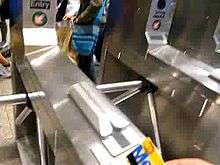
Overslept,
So tired.
If late,
Get fired.
Why bother?
Why the pain?
Just go home
Do it again.
The last panel is a picture of a bed. The panels were part of an art project that was supposed to last only one year, but was never removed.[6]
This station underwent total reconstruction in stages starting in 1994. The reconstruction included a new entryway on the south side of 42nd Street between Seventh Avenue and Broadway, featuring a bright neon and colored glass flashing sign with the train route symbols and the word "Subway". The street level fare control at this site features restored original "Times Square" mosaics from the Contract I station walls (now used by the shuttle), and both escalators and stairs lead into the complex. There are also similar renovated entrances on the northwest and southwest corners of Seventh Avenue and 42nd Street, the latter of which has both escalators and stairs, while the former has only stairs.
In 1999, a US$44 million renovation of the complex began. The goal was to reduce congestion and improve rider access, comfort and safety by improving visual lines and increasing pedestrian capacity. The main corridor was widened 15 feet (4.6 m), and the number of sharp corners reduced; ADA accessibility was introduced with elevators; new escalators; and other corridors were widened. The mezzanine above the BMT Broadway Line, formerly a record shop, now features a large oval balcony looking over the trackway and has reduced the sense of claustrophobia described by many riders. In 2004, four unisex stall bathrooms were opened on the mezzanine between the IRT and BMT lines; they are staffed and maintained by employees of the Times Square Alliance, the local Business Improvement District. The record shop re-opened in 2007 on the south side of the IRT/BMT corridor.[7]
The mezzanine has been a major featured spot for subway performers ever since the opening of the station. "Music Under New York" controls the spot, which is located by the escalators, opposite the shuttle to Grand Central. Musicians of all types, from musical saw to a brass band, perform there daily.
Relative depths
The relative depths of the station's platforms are:[8]
- IRT 42nd Street Shuttle, 20 feet (6.1 m) below street
- IND Eighth Avenue Line (one block west), 30 feet (9.1 m)
- IRT Broadway – Seventh Avenue Line, 40 feet (12 m)
- BMT Broadway Line, 50 feet (15 m)
- IRT Flushing Line, 60 feet (18 m)
IRT 42nd Street Shuttle platforms
| Times Square | |||||||
|---|---|---|---|---|---|---|---|
| New York City Subway rapid transit station | |||||||
|
Shuttle platform for track 1 | |||||||
| Station statistics | |||||||
| Division | A (IRT) | ||||||
| Line | IRT 42nd Street Shuttle | ||||||
| Services |
S | ||||||
| Structure | Underground | ||||||
| Platforms | 3 side platforms (all connected at west end) | ||||||
| Tracks | 3 | ||||||
| Other information | |||||||
| Opened | October 27, 1904[9] | ||||||
| Former/other names | 42nd Street | ||||||
| Station succession | |||||||
| Next north |
Tracks 1 and 3: (Terminal): S Track 4: 50th Street: no regular service | ||||||
| Next south |
Grand Central: S | ||||||
| |||||||
When it first opened in October 1904, Times Square was a local station on New York City's first subway. Three shuttle tracks have served it since 1918; the southbound express track was removed and replaced by a temporary wooden platform for access to the original northbound express track.
On both sides platforms are located (at the old local platforms) and where the southbound express track was; all three platforms connect on the west (railroad north) side. This walkway crosses the northbound local track on a bridge that can be lifted for the only access to that track, via a merge into the northbound IRT Broadway – Seventh Avenue Line local track along the original subway alignment (north of the current Broadway – Seventh Avenue Line station). This track merge is only used for overnight swaps and special railfan excursion trains. The other three tracks once curved parallel to this.
Two of the three tracks end at bumper blocks at the west end of the platforms. Between the northbound local and the other tracks anywhere along the shuttle there is no track connection.
Because of the curvature on the platforms, gap fillers are used to bridge the gap between train and platform; however, the gap fillers, which are under the platform rather than flush with the platform, are not suitable for wheelchair passengers, making the shuttle platforms virtually inaccessible to wheelchair users. Such passengers who need service to Grand Central must use the IRT Flushing Line platforms. An underpass that formerly connected the original side platforms lies between the downtown local track and the other three tracks of the BMT Broadway Line, which runs perpendicular to the shuttle.
Tracks 1 and 3 have gap fillers. Track 4 does not have gap fillers because of the convex curve of the platform. Track 4 can barely fit the three cars of the shuttle; it originally ended at a wall but now has a small extension for alighting passengers, so the last pair of doors of the train keep one panel disabled for added safety. Track 3 can accommodate trains with four cars as well as space for half a fifth.
This is the only station in the station complex that does not have ADA-accessibility, but the MTA is scheduling some improvements to make it accessible under the guidelines of the Americans With Disabilities Act of 1990 as part of the 2015–2019 MTA Capital Program. As part of the program, the 42nd Street Shuttle will become ADA accessible, and the shuttle will be reconfigured from three tracks to two tracks, and the trains will become six cars long. The whole project will cost $235.41 million. The Times Square shuttle platform will be extended to allow for a second point of entry, this one being at Sixth Avenue, with a connection to the IND Sixth Avenue Line. The Times Square station will be rehabilitated with congestion mitigation measures. A wider stairway would be installed from the shuttle mezzanine to street level, a new control area would be installed at the bottom of the stairway, and 21 columns would be removed. The connection to the Broadway–Seventh Avenue Line would probably be removed with the elimination of Track 4. The cost of this part of the project is $28.93 million.[10][11]
IND Eighth Avenue Line platforms
| 42nd Street–Port Authority Bus Terminal | |||||||||||
|---|---|---|---|---|---|---|---|---|---|---|---|
| New York City Subway rapid transit station | |||||||||||
|
Downtown platform. | |||||||||||
| Station statistics | |||||||||||
| Division | B (IND) | ||||||||||
| Line | IND Eighth Avenue Line | ||||||||||
| Services |
A C E | ||||||||||
| Structure | Underground | ||||||||||
| Platforms |
2 island platforms cross-platform interchange | ||||||||||
| Tracks | 4 | ||||||||||
| Other information | |||||||||||
| Opened |
September 10, 1932[12] (upper level) August 25, 1952[13] (lower level) | ||||||||||
| Closed | 1981 (lower level) | ||||||||||
| Accessible |
| ||||||||||
| Station succession | |||||||||||
| Next north |
50th Street (local): A 59th Street–Columbus Circle (express): A 50th Street (Queens Boulevard): E | ||||||||||
| Next south |
34th Street–Penn Station: A | ||||||||||
|
| |||||||||||
| Next |
59th Street–Columbus Circle (8th Ave): A Lexington Avenue–53rd Street (Queens Boulevard): E | ||||||||||
| Next |
34th Street–Penn Station: A | ||||||||||
| |||||||||||
42nd Street–Port Authority Bus Terminal is an express station on the IND Eighth Avenue Line. It is partly underneath the Port Authority Bus Terminal. It has one platform level, two offset island platforms, and a long mezzanine. Formerly, it also had a lower level with a single side platform. The upper level opened on September 10, 1932,[12][14] and the lower level opened on August 25, 1952.[13]
Platform level
The platform level of the station contains four tracks and two island platforms; the northbound platform extends from 42nd to 44th Streets, while the southbound platform extends from 40th to 42nd Streets. The station's mezzanine extends four blocks from 40th to 44th Streets, and connects with the rest of the complex by a long passageway underneath 41st Street.[15][16]
Former lower level
In addition to the level currently in use, there was formerly a lower platform on the southbound side (one track underneath the downtown local track on the upper level, and one side platform underneath the island platform above). The lower level was built together with the upper level platforms in the late 1920s/early 1930s, but existed as an unfinished shell until it was completed and opened in August 1952 to serve rush hour E trains.[13][17] For most of its existence, the lower level platform was only used for occasional service specials, including summer "Rockaway Special" trains to Beach 98th Street at the Rockaways' Playland beginning in 1958, the Aqueduct Racetrack special fare trains from 1959 to 1981, and rush hour E trains in the 1970s, beginning on March 23, 1970.[18][19][20][21]
The lower level featured two high-speed escalators to the mezzanine, and three staircases to the upper-level platform. The walls featured 1950s-era cream tiles, a purple and black tile band, and white mosaic name plates with black "42ND ST" text.[13][17][18]
Theories differ on why the lower level platform was built. The platform could only be reached by trains originating from Queens via the IND Queens Boulevard Line, and 53rd Street (the current E service). Some commentators have speculated that this was meant to allow Manhattan-bound E trains from Queens to hold at 42nd Street without slowing down service on trains traveling from Central Park West,[19] while the reported purpose of the platform upon its opening was to allow E trains to load and unload passengers without having to wait for one of the two upper level tracks to clear.[13][17] Others have suggested that the lower level platform was built to prevent the IRT Flushing Line from being extended westward. The IND lower level platform was located just beyond the tail tracks on the IRT Flushing Line platform.[16][19][22]
Film producers have used the lower level platform for several films, most notably Ghost (1990), starring Patrick Swayze and Demi Moore.[18][19]
In the late 2000s, the MTA began construction on a planned extension of the IRT Flushing Line to 34th Street, which would require demolishing the IND Eighth Avenue lower level platform.[19] As of January 2010, the lower level platform was being demolished as part of the Flushing Line extension.[23] Transit blogger Benjamin Kabak, who was invited to tour the Flushing Line extension and view construction progress, reported in February 2012 that the lower level platform had been "bisected" by the Flushing Line extension.[24] The tunnels slope down through where the old lower level platform was.[22]
IRT Broadway–Seventh Avenue Line platforms
| Times Square–42nd Street | |||||||||||
|---|---|---|---|---|---|---|---|---|---|---|---|
| New York City Subway rapid transit station | |||||||||||
|
Downtown platform | |||||||||||
| Station statistics | |||||||||||
| Division | A (IRT) | ||||||||||
| Line | IRT Broadway–Seventh Avenue Line | ||||||||||
| Services |
1 2 3 | ||||||||||
| Structure | Underground | ||||||||||
| Platforms |
2 island platforms cross-platform interchange | ||||||||||
| Tracks | 4 | ||||||||||
| Other information | |||||||||||
| Opened | June 3, 1917[1] | ||||||||||
| Accessible |
| ||||||||||
| Station succession | |||||||||||
| Next north |
50th Street (local): 1 72nd Street (express): 2 | ||||||||||
| Next south |
34th Street–Penn Station: 1 (Terminal): 3 | ||||||||||
|
| |||||||||||
| Next |
59th Street–Columbus Circle (local): 1 72nd Street (express): 2 | ||||||||||
| Next |
34th Street–Penn Station: 1 none: 3 | ||||||||||
| |||||||||||
Times Square–42nd Street is an express station on the IRT Broadway–Seventh Avenue Line, with four tracks and two island platforms. Access to the other lines is provided at the northern end and in the center of each platform. An elevator leads from each platform to the mezzanine; the southbound elevator also leads to the Flushing Line platform.
Just south of the station, a fifth center track begins, formed by a connection from each express track. This track merges back into the two express tracks just before 34th Street–Penn Station.[25] This center track was used in the past for turning rush hour "Gap Trains", which would head back up north. It is currently used for short turning 3 trains during nights.[26]
This section was the site of a 1928 wreck that killed 16 people, the second worst in New York City history (the worst being the Malbone Street Wreck in Brooklyn, which killed at least 93).
BMT Broadway Line platforms
| Times Square–42nd Street | |||||||||||||
|---|---|---|---|---|---|---|---|---|---|---|---|---|---|
| New York City Subway rapid transit station | |||||||||||||
|
Uptown platform | |||||||||||||
| Station statistics | |||||||||||||
| Division | B (BMT) | ||||||||||||
| Line | BMT Broadway Line | ||||||||||||
| Services |
N Q R W | ||||||||||||
| Structure | Underground | ||||||||||||
| Platforms |
2 island platforms cross-platform interchange | ||||||||||||
| Tracks | 4 | ||||||||||||
| Other information | |||||||||||||
| Opened | January 5, 1918[27] | ||||||||||||
| Accessible |
| ||||||||||||
| Station succession | |||||||||||||
| Next north |
49th Street (local): N 57th Street–Seventh Avenue (express): Q | ||||||||||||
| Next south |
34th Street–Herald Square: N | ||||||||||||
|
| |||||||||||||
| Next |
49th Street: N Lexington Avenue–63rd Street: under construction | ||||||||||||
| Next |
34th Street–Herald Square: N | ||||||||||||
| |||||||||||||
Times Square–42nd Street is an express station on the BMT Broadway Line that has four tracks and two island platforms. Connections to the other lines are at the northern end of the platforms. This station received a minor overhaul in the late 1970s when MTA fixed the station's structure and the overall appearance, and it repaired staircases and platform edges, removed pedestrian ramps, and replaced lighting. In 2004-2006, the station received a major overhaul and repairs, including upgrading the station for ADA compliance and restoring the original late 1910s tiling. MTA repaired the staircases, retiled the walls, added new tiling on the floors, upgraded the station's lights and the public address system, installed ADA yellow safety treads along the platform edge, and installed new signs and new trackbeds in both directions.
The express tracks north of the station spread out to pass around a crossunder in the Times Square shuttle platforms. This crossunder was sealed off in the 1960s.
On June 1, 1940, the title of the Brooklyn–Manhattan Transit Corporation was transferred to the City of New York, signifying the first phase of unification of New York's subway system with the Independent Subway System as well as eventual public operation of the entire system. (The Interborough Rapid Transit Company would be merged on June 15 of the same year.) At midnight, a ceremony commemorating the transfer, with five hundred people in attendance, was held at the Times Square station. The last BMT train had left the 57th Street station five minutes earlier. When the train arrived at Times Square, BMT president William S. Menden handed over his company's properties to Mayor Fiorello H. LaGuardia, who then gave them to New York City Board of Transportation chairman John H. Delaney. The Board of Transportation operated the New York City Transit System until the creation of the New York City Transit Authority in 1953.[28]
IRT Flushing Line platform
| Times Square-42nd Street | |||||||||
|---|---|---|---|---|---|---|---|---|---|
| New York City Subway rapid transit station | |||||||||
|
The IRT Flushing Line platform | |||||||||
| Station statistics | |||||||||
| Division | A (IRT) | ||||||||
| Line | IRT Flushing Line | ||||||||
| Services |
7 | ||||||||
| Structure | Underground | ||||||||
| Platforms | 1 island platform | ||||||||
| Tracks | 2 | ||||||||
| Other information | |||||||||
| Opened | March 14, 1927[29] | ||||||||
| Accessible |
| ||||||||
| Station succession | |||||||||
| Next north |
Fifth Avenue: 7 | ||||||||
| Next south |
34th Street–Hudson Yards: 7 | ||||||||
|
| |||||||||
| Next |
Grand Central: 7 | ||||||||
| Next |
34th Street–Hudson Yards: 7 | ||||||||
| |||||||||
Times Square (signed as and announced on trains as Times Square–42nd Street) on the IRT Flushing Line has one island platform and two tracks, located deep below West 41st Street.
History
The Times Square station opened on March 14, 1927, extending the Flushing Line westward from its previous terminus at Fifth Avenue.[30] This station served as the terminus for 7 <7> trains from its opening on March 14, 1927, until September 13, 2015, when the next station west (railroad south), 34th Street–Hudson Yards, opened.[31] The platforms at Times Square and all other stations on the Flushing Line with the exception of Queensboro Plaza were extended in 1955–1956 to accommodate 11-car trains.[32]
Layout
Stairs, escalators, and an elevator along the platform lead to various mezzanines. There are "TS" tile mosaics along the station walls. An office is located at the north (compass east) end of the platform. An elevator was recently installed and connects with the Downtown IRT Seventh Avenue platform and then the mezzanine. The elevators make this platform, along with the platform at Grand Central accessible to wheelchair passengers (unlike the shuttle platforms, which are not accessible to wheelchairs).
The tracks continue south (compass west) beyond the station to the 34th Street station. These tracks formerly led to an unused storage and layover area, but the extension of the Flushing Line, whose trackwork was completed in 2013, included the addition of third rails to the layover tracks, as well as the inspection and replacement of these tracks.[33] The closed lower level platform at 42nd Street–Port Authority Bus Terminal on the IND Eighth Avenue Line was blocking the line but since removed.[18] Currently, all Flushing-bound service is on the eastbound track, labeled Track 2, and 34th Street-bound service is on the westbound track, labeled Track 1.
Artwork
George Lewis Heins and Christopher Grant LaFarge were the first commissioned architects of the IRT. They designed the original Times Square Station, which was located at the current Grand Central Shuttle stop.
In many of their stations, Heins and LaFarge use symbolic imagery to honor a neighborhood or its namesake. When Squire Vickers took over as chief designer and architect of the IRT in 1906, he continued this tradition of using symbolism to speak to a station's history.
The colored tile trim of the Times Square subway station bears an uncanny resemblance to the Confederate Battle Flag.[34] Scholars believe that Vickers and his colleagues unmistakably reference the symbol of the South to pay homage to New York Times owner Adolph S. Ochs.[35] The Confederacy was a significant part of Ochs' heritage, and the eccentric Vickers relished literary and historical imagery.[36] Times Square was named for the New York Times, whose headquarters, built by the Southerner Ochs, housed the original subway station in its basement.
-

Original colored tile trim, before the station renovation of the late 1990s. Scholars believe architect Squire J. Vickers used this design to pay homage to the Southern roots of former New York Times newspaper head Adolph S. Ochs
-

The colored tile trim of the renovated station recreates Vickers' tile mosaic tribute to Adolph Ochs
-
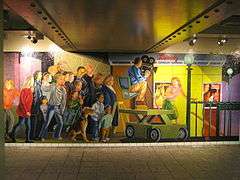
The Return of Spring/The Onset of Winter by Jack Beal
-
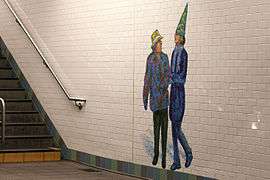
The Revelers by Jane Dickson
-

New York in Transit by Jacob Lawrence
-

Times Square Times by Toby Buonagurio
Modern artwork installed in the complex includes the following:
- New York in Transit by Jacob Lawrence, 2001
- The Return of Spring/The Onset of Winter by Jack Beal, 2001/2005
- Times Square Mural by Roy Lichtenstein, 2002 (collage 1990, fabricated 1994)
- Times Square Times: 35 Times by Toby Buonagurio, 2005
- The Revelers by Jane Dickson, 2008
New York in Transit was Lawrence's last public work before his 2000 death.[37] Lichtenstein completed Times Square Mural in 1994, but installation was delayed until after the station complex's renovation, during which Lichtenstein died in 1997.[38]
Foiled terrorist attack
Najibullah Zazi and alleged co-conspirators were arrested in September 2009 as part of an al-Qaeda Islamist plan to engage in suicide bombings on trains in the New York City subway system, including near the Times Square station, during rush hour that month, and Zazi has pleaded guilty.[39][40][41][42]
References
Notes
- 1 2 New York Times, Three New Links of the Dual Subway System Opened, June 3, 1917, page 33
- ↑ "NYC Subway Wireless – Active Stations". Transit Wireless Wifi. Retrieved 2016-05-18.
- 1 2 "Facts and Figures: Annual Subway Ridership". Metropolitan Transportation Authority. Retrieved 2016-04-18.
- ↑ "600-Foot Pedestrian Tunnel, Linking Subways, Opens Today". Retrieved 2016-10-10.
- ↑ New York Times, Transfer Points Under Higher Fare, June 30, 1948, page 19
- ↑ "Artwork: "The Commuter's Lament/A Close Shave", Norman B. Colp (1991)". Retrieved 2008-10-22.
- ↑ Review and photos of the Times Square bathrooms at Gothamist
- ↑ nycsubway.org – IND 8th Avenue: 42nd Street-Port Authority Bus Terminal
- ↑ New York Times, Our Subway Open: 150,000 Try It, October 28, 1904
- ↑ "METROPOLITAN TRANSPORTATION AUTHORITY (MTA) NOTICE OF PUBLIC HEARING AND DESCRIPTION OF PROJECTS Tuesday, August 23, 2016 4:30 P.M. Request for Federal Financial Assistance Under the Federal Transportation Authorization For Federal Fiscal Year 2017 Capital Improvement Projects" (PDF). mta.info. Metropolitan Transportation Authority. July 28, 2016. Retrieved August 7, 2016.
- ↑ 2015–2019 MTA Capital Program
- 1 2 New York Times, List of the 28 Stations on the New Eighth Ave Line, September 10, 1932, page 6
- 1 2 3 4 5 "New IND Platform Will Open Monday". nytimes.com. The New York Times. August 23, 1952. Retrieved 30 June 2015.
- ↑ Crowell, Paul (September 10, 1932). "Gay Midnight Crowd Rides First Trains In The New Subway: Throngs at Station an Hour Before Time, Rush Turnstiles When Chains are Dropped". New York Times. Retrieved 8 November 2015.
- ↑ "MTA Neighborhood Maps: Pennsylvania Station/Times Square" (PDF). mta.info. Metropolitan Transportation Authority. 2015. Retrieved 11 December 2015.
- 1 2 "Station: 42nd Street-Port Authority Bus Terminal (8th Avenue)". Retrieved 2013-04-06.
- 1 2 3 Ingraham, Joseph C. (June 20, 1952). "New IND Platform at 8th and 42d To Expedite Service From Queens". nytimes.com. The New York Times. Retrieved 30 June 2015.
- 1 2 3 4 Mindlin, Alex (2008-04-20). "No Whoosh, No 'All Aboard'". The New York Times. Retrieved 2009-07-10.
- 1 2 3 4 5 Kabak, Benjamin (2008-04-21). "With the 7 on the way, a swan song for a Times Square platform". Retrieved 2013-04-06.
- ↑ Brennan, Joseph (2002). "Abandoned Stations: 42 St Lower Level". Retrieved 2015-05-04.
- ↑ "Non-Stop Trips, Reserved Seats On Special Here: Deluxe Subway Express Ride Also Features Music; $1.55 Round-Trip Fare From 42nd Street To Playland Station Provides Admission And Rides" (PDF). Wave of Long Island. Fultonhistory.com. July 3, 1958. p. 1. Retrieved 17 August 2016.
- 1 2 "7 Line Extension 081". Flickr.
- ↑ Donohue, Pete (2009-06-20). "Abandoned No More: 2nd Life Drilled into Old 7 Subway Platform". New York Daily News. Retrieved 2010-01-30.
- ↑ Kabak, Benjamin (2012-02-12). "Photos: Inside the 7 line extension". Retrieved 2013-04-06.
- ↑ Marrero, Robert (2015-09-13). "469 Stations, 846 Miles" (PDF). B24 Blog, via Dropbox. Retrieved 2015-10-09.
- ↑ "Service Enhancements on 3 Line" (Press release). MTA New York City Transit. 2008-07-24. Retrieved 2008-07-26.
- ↑ New York Times, Open New Subway to Times Square, January 6, 1918
- ↑ Hood, Clifton (2004). 722 Miles: The Building of the Subways and How They Transformed New York (Centennial ed.). Johns Hopkins University Press. pp. 238–239. ISBN 0-8018-8054-8.
- ↑ New York Times, New Queens Subway Opened to Times Sq., March 15, 1927, page 1
- ↑ "New Queens Subway Opened to Times Sq.". The New York Times. March 15, 1927. p. 1. Retrieved 2011-10-02.
- ↑ "New 34 St-Hudson Yards 7 Station Opens". Building for the Future. New York, New York: Metropolitan Transit Authority. Archived from the original on March 4, 2016. Retrieved March 10, 2016.
The new station opened September 13, 2015
- ↑ Authority, New York City Transit (1955-01-01). Minutes and Proceedings.
- ↑ "View of Tunnel from station platform showing sign indicating no third rail power". Retrieved 2009-04-01.
- ↑ "Confederate Flags in Times Square?". History Net: Where History Comes Alive – World & US History Online.
- ↑ Jackowe, David J. "The Times Square Confederate." Civil War Times; Aug 2012, Vol. 51 Issue 4, p. 42. http://www.historynet.com/confederate-flags-in-times-square.htm
- ↑ Underground Renaissance Man: Watch the Aesthetic Walls, Please
- ↑ "Times Square Subway Mural Unveiled" (Press release). Metropolitan Transportation Authority. 2001-11-07. Retrieved 2010-04-11.
- ↑ Carol Vogel. "Times Square Mural". The Roy Lichtenstein Foundation. Retrieved 2010-04-11.
- ↑ Zraik, Karen; Johnston, David (September 15, 2009). "Man in Queens Raids Denies Any Terrorist Link". The New York Times. Archived from the original on September 21, 2009.
- ↑ Johnston, David; Baker, Al (September 18, 2009). "Denver Man Admits to a Possible Al Qaeda Connection, Officials Say". The New York Times. Archived from the original on September 21, 2009.
- ↑ Johnston, David; Rashbaum, William K. (September 20, 2009). "Terror Suspect Had Bomb Guide, Authorities Say". The New York Times. Archived from the original on September 21, 2009.
- ↑ Zazi Reveals Details Of Foiled Terror Plot - retrieved from NY1 local news channel on 04/12/2010
Further reading
- Lee Stokey. Subway Ceramics : A History and Iconography. 1994. ISBN 978-0-9635486-1-0
External links
| Wikimedia Commons has media related to Times Square – 42nd Street / Port Authority Bus Terminal (New York City Subway). |
nycsubway.org:
- nycsubway.org – IRT Grand Central/Times Square Shuttle: Times Square
- nycsubway.org – IRT Flushing Line: Times Square
- nycsubway.org – IRT West Side Line: Times Square/42nd Street (text used with permission)
- nycsubway.org – BMT Broadway Subway: Times Square/42nd Street
- nycsubway.org – IND Eighth Avenue Line: 42nd Street/Port Authority Bus Terminal
- nycsubway.org – New York in Transit Artwork by Jacob Lawrence (2001)
- nycsubway.org – Times Square Mural Artwork by Roy Lichtenstein (1994)
- nycsubway.org – The Return of Spring/The Onset of Winter Artwork by Jack Beal (1999)
- nycsubway.org – Times Square Times: 35 Times Artwork by Toby Buonagurio (2005)
- nycsubway.org – The Revelers Artwork by Jane Dickson (2007)
- nycsubway.org – Losing My Marbles Artwork by Lisa Dinhofer (2003)
- nycsubway.org – The Commuter's Lament/A Close Shave Artwork by Norman B. Colp (1991)
MTA Arts for Transit
- MTA's Arts For Transit – 42nd Street–Port Authority Bus Terminal (IND Eighth Avenue Line)
- MTA's Arts For Transit – Times Square–42nd Street, Page 1
- MTA's Arts For Transit – Times Square–42nd Street, Page 2
- MTA's Arts For Transit – 42nd Street–Port Authority Bus Terminal (IND Eighth Avenue Line)
Google Maps Street View
- 42nd Street and Seventh Avenue entrance from Google Maps Street View
- 42nd Street and Broadway entrance from Google Maps Street View
- 43rd Street and Broadway entrance from Google Maps Street View
- 41st Street and Seventh Avenue entrance from Google Maps Street View
- 40th Street and Seventh Avenue entrance to IRT Lines from Google Maps Street View
- 40th Street and Broadway entrance to Broadway Line and Shuttle from Google Maps Street View
- 42nd Street and Eighth Avenue entrance from Google Maps Street View
- 44th Street and Eighth Avenue entrance from Google Maps Street View
- 40th Street and Eighth Avenue entrance from Google Maps Street View
- Mezzanine from Google Maps Street View
- Eighth Avenue Line uptown platform from Google Maps Street View
- Eighth Avenue Line mezzanine from Google Maps Street View
- Flushing Line platform from Google Maps Street View
- Shuttle platforms from Google Maps Street View
- BMT platforms from Google Maps Street View
- Broadway - Seventh Avenue Line downtown platform from Google Maps Street View
Other websites
- MTA's YouTube Web Page – Advertising Initiatives 9/21/2010 on the 42nd Street (S) Shuttle. Retrieved September 22, 2010. (2:13 video clip)
- NYCTA Subway Station Tour: 42nd Street–Port Authority/Times Square
- Forgotten NY – Original 28 - NYC's First 28 Subway Stations
- The Subway Nut – Times Square–42nd Street (7) pictures




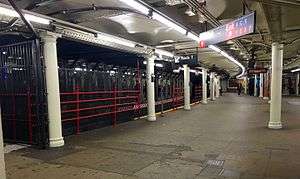
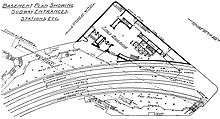
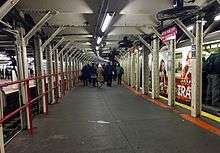

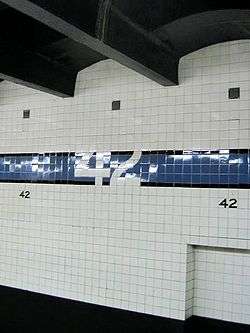
.jpg)
